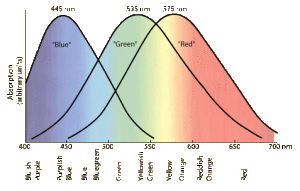2012 article
Joshua J. Gooley,1,2,3 Ivan Ho Mien,4 Melissa A. St. Hilaire,2,3 Sing-Chen Yeo,5 Eric Chern-Pin Chua,1 Eliza van Reen,2,3 Catherine J. Hanley,2 Joseph T. Hull,2,3 Charles A. Czeisler,2,3 and Steven W. Lockley2,3
1 Program in Neuroscience and Behavioral Disorders, Duke–National University of Singapore Graduate Medical School Singapore, Singapore 169857,
2 Division of Sleep Medicine, Department of Medicine, Brigham and Women’s Hospital, and
3 Division of Sleep Medicine, Department of Medicine, Harvard Medical School, Boston, Massachusetts 02115, 4 Graduate School for Integrative Sciences and Engineering, National University of Singapore, Singapore 117456, and 5 National Neuroscience Institute, Singapore 308433
In mammals, the pupillary light reflex is mediated by intrinsically photosensitive melanopsin-containing retinal ganglion cells that also receive input from rod– cone photoreceptors. To assess the relative contribution of melanopsin and rod– cone photoreceptors to the pupillary light reflex in humans, we compared pupillary light responses in normally sighted individuals (n � 24) with a blind individual lacking rod– cone function. Here, we show that visual photoreceptors are required for normal pupillary responses to continuous light exposure at low irradiance levels, and for sustained pupillary constriction during exposure to light in the long-wavelength portion of the visual spectrum. Inthe absence of rod– conefunction, pupillomotor responses are slow and sustained, and cannottrackintermittent light stimuli, suggesting that rods/cones are required for encoding fast modulations in light intensity. In sighted individuals, pupillary constriction decreased monotonically for at least 30 min during exposureto continuous low-irradiance light, indicatingthat steady-state pupillary responses are an order of magnitude slower than previously reported. Exposure to low-irradiance intermittent green light (543 nm; 0.1– 4 Hz)for 30 min, which was givento activate cone photoreceptors repeatedly, elicited sustained pupillary constriction responses that were more than twice as great compared with exposure to continuous green light. Our findings demonstrate nonredundant roles for rod– cone photoreceptors and melanopsin in mediating pupillary responses to continuous light. Moreover, our results suggest that it might be possible to enhance nonvisual light responses to low-irradiance exposures by using intermittent light to activate cone photoreceptors repeatedly in humans.
Introduction
The pupillary light reflex (PLR) regulates the amount of light that reaches the retina. In doing so, the PLR optimizes visual acuity over a wide range of illuminance levels (Campbell and Gregory, 1960) and protects the retina from the potentially damaging effects of exposure to bright light. The PLR is mediated by melanopsin-containing retinal ganglion cells that project directly to the olivary pretectal nucleus (Hattar et al., 2002; Gooley et al., 2003). Melanopsin cells are intrinsically photosensitive and respond most strongly to short-wavelength light in the blue portion of the visual spectrum (Berson et al., 2002; Dacey et al., 2005). Rod– cone photoreceptors also provide input to melanopsin cells (Belenky et al., 2003; Wong et al., 2007), but melanopsin cells are not required for pattern-forming vision (Gu¨ler et al., 2008). In contrast, the PLR and other nonvisual light responses are abolished if rod– cone and melanopsin signaling pathways are disrupted simultaneously (Hattar et al., 2003; Panda et al., 2003), or if melanopsin cells are selectively killed (Gu¨ler et al., 2008). In humans, rods and cones are capable of driving the initial rapid constriction of the pupils in response to light (Alpern and Campbell, 1962), whereas the PLR is most sensitive to shortwavelength blue light during exposure to continuous light (Bouma, 1962; Alexandridis and Koeppe, 1969; Mure et al., 2009; McDougal and Gamlin, 2010), even in the absence of rod and cone function (Zaidi et al., 2007), suggesting a primary role for melanopsin photopigment. For light intensities below the threshold of activation for melanopsin cells, spectral responses of the PLR during exposure to continuous light are consistent with a role for rods, with little or no contribution from cones (McDougal and Gamlin, 2010). By comparison, attempts to isolate visual photoreceptor contributions to the PLR using the method of silent substitution have yielded contrasting results, with one study reporting a contribution from M- and L-cones (Tsujimura et al., 2010), and another reporting a possible contribution from rod photoreceptors (Vie´not et al., 2010). Melanopsin and rod–cone contributions to the PLR are difficult to assess in normally sighted humans due to overlap of spectral sensitivity for the various photoreceptor types. As demonstrated in macaques, which have trichromatic vision similar to humans, melanopsin-dependent pupillary responses can be examined in isolation when rod– cone signaling is disrupted (Gamlin et al., 2007). Hence, the role of melanopsin versus rod– cone photoreceptors in driving pupillary light responses could potentially be assessed in blind humans with complete loss of visual function, but with preservation of the retinal ganglion cell layer and melanopsin function (Czeisler et al., 1995; Klerman et al., 2002; Zaidi et al., 2007). To date, however, fewer than a dozen such patients have been identified worldwide. In the present study, we provide a detailed analysis of pupillary light responses in a patient with intact nonvisual responses to light (Zaidi et al., 2007), but without a functional outer retina. Here, the relative contribution of melanopsin and visual photoreceptors was assessed by comparing PLR responses in the totally visually blind patient with normally sighted individuals.
…
Full article here

